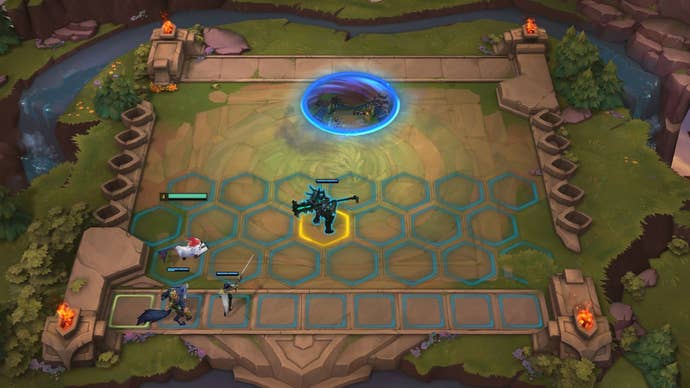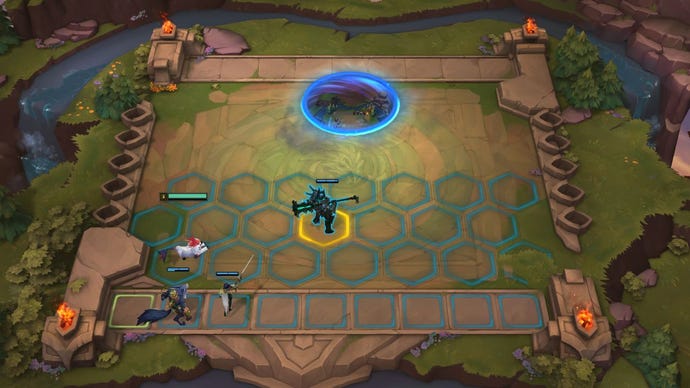We Played Teamfight Tactics, Riot's New Auto Chess, and It's Looking Like A Real Competitor
A new game mode for League could pose some real competition.
This article first appeared on USgamer, a partner publication of VG247. Some content, such as this article, has been migrated to VG247 for posterity after USgamer's closure - but it has not been edited or further vetted by the VG247 team.
Riot Games is stepping into the autobattler ring with Teamfight Tactics, its take on the increasingly popular game type formed by Dota Auto Chess. But rather than a simple lift of concept with a layer of League, Teamfight Tactics makes smart changes to the formula that could entice those who haven't dived into the chess pool yet.
The MOBA genre's genesis is modification. Games like League of Legends owe their legacy, in part, to the inspiration found in mods like Defense of the Ancients. So it's fitting that Riot Games, for its first new foray outside the confines of hero combat, turns to a source like Auto Chess.
"It started back in January, shortly after Auto Chess had come out," says Richard Henkel, product manager of Teamfight Tactics. "One of our design leads sent out an email saying, 'Hey, there's this Auto Chess game, this is high level how it's played, I think it's pretty fun, we should maybe check it out.'"
A growing interest soon turned into a project for the group that became the Teamfight Tactics team, as about 12 developers conglomerated to create their own take on it. They began to look at what a version of Auto Chess would look like for them, though Riot Games refers to it as the "autobattler" genre; a more apt description, considering Teamfight Tactics sheds the chess imagery, opting for a hexagonal board.
If you're not familiar with the autobattler genre, it combines elements of tower defense, card games, and tactics games. Eight players earn gold to spend on units, which they put into position on a board. Your board then fights other players' boards while you defend your own. If your board loses, you take damage according to the amount of surviving enemy units, and you proceed to the cycle of buying units, placing them, and fighting.

The intricacy is in the details, where each unit has varying levels of rarity, as well as characteristics that can synergize with others - in Teamfight Tactics, their origin and class - to award added benefits. Fielding a certain amount of Yordle units will give them a chance to dodge attacks, while enough Void origin units will make your units' attacks pierce armor. Adding more Gunslingers to your lineup lets their attacks hit additional enemies, while Pirates give extra gold at the end of player vs. player rounds. Include the nuance of individual unit abilities, ranging from transformations and crowd-control to raw damage, and there are a lot of ways you can customize your board to beat another one.
Autobattlers are about balancing these benefits, adjusting your build to beat others while not falling behind. Spend too much gold, and you won't benefit from the interest a stockpile generates each round. Forego levelling up for re-rolling your unit shop, and soon your board's max unit count will fall behind the pack. Autobattlers encourage a careful, thoughtful balance akin to poker; you have to know when to all-in, and when to play safe.
What Riot is trying to do with its take on the genre is address places where new players struggle, while putting a new spin on it. Items are basic building blocks that automatically combine into more powerful upgrades. Basic item drops like a cloak or sword give basic stats, but a unit carrying two will automatically combine them into a greater weapon, adding a layer of choice and strategy to how you distribute your armory.
A synergy counter along the left-hand side clearly indicates the tier of boon your lineup has reached in any given bonus. It even tracks it by tier, denoting which level you've hit with gold, silver, or bronze. Despite being built in the League of Legends engine, the interface and layout seems tailored to the purpose of autobattling. It's very different from the sometimes ramshackle framework of modifying an existing game to fit another genre.
"The main thing we started out with at the beginning was less about, what's the framework of Auto Chess, though that was a very helpful thing," says Henkel. "But it was more about what are all the pain points that players experience that we can potentially resolve, and what are the experiences we want to capture that we don't think have been captured yet?"
The most notable difference is how interactive Teamfight Tactics is, especially in the way its player avatar - or "little legend" - plays into the action. Your board actually teleports to other boards, with your perspective and avatar following. In a clever twist, you take an active role in the action on a roulette wheel in rounds called "shared draft." At times I heard it referred to as the "carousel," or as I likened it, "Hungry Hungry Hippos."
At the beginning of the game, each player's avatar spawns in a concentric ring, with the inner ring displaying a rotating carousel of units. These are free to grab, for whoever grabs one first; the first is a free-for-all, while later rounds let players loose on the available units one at a time, starting with the player at the lowest health and going up to first place.
It isn't just a good comeback mechanic, but it makes each match more animated and interactive, aspects missing from other autobattlers. Where other games have boards magically spawning units and the player character a largely disassociated cursor, Riot Games wants to add a little more personality.
"We wanted to make players feel like they were playing a game that was fun and a game that they were playing with people, and hopefully their friends," says Henkel. "We wanted to make it a very social experience."
Playfully competitive is how Henkel describes the attitude, and to its benefit, Teamfight Tactics is that. Within just a handful of games, I already felt at home, eyeing other players' boards and denoting synergies I could be building up, in the ultimate goal of thrashing my seven various opponents. But that's typical for the genre.
What stuck with me were the rounds like the shared draft, where we would drop into a ring and see champions pop up in front of us. Those with low lives darted for high-rarity champions, snatching up characters like Swain or Anivia. The middle of the pack went for their synergies, or the last of three champions they would need to combine and upgrade a unit in their roster. If you were last, it was table scraps. But that was a tension that made playing Teamfight Tactics feel like a much more involved, active experience.
While I got a little animated during those rounds, the genre is still ultimately less demanding than a MOBA like League of Legends. As Henkel notes, this can appeal to a shifting age group within the League and gaming community. It's a more relaxed experience, where he, as a father of two children, can relax and watch Netflix while battling through a game or two.
How much does this impact League of Legends? The answer is a combination of a lot and a little. While League will exist as normal, and Teamfight Tactics is ostensibly a separate game mode rather than full-on game, Henkel says they want it to live inside its own area of the client. His team has aspirations of a ranked queue, and a "split flow" where users downloading the League client can opt out of the MOBA tutorial if they're looking to play just Teamfight Tactics.
It all depends on whether this genre has legs. While it's been setting record numbers for Valve's Dota 2, that doesn't necessarily forecast long-term success in the way League of Legends had it. And as the land rush for autobattlers continues, with Valve and original mod developer Drodo Studio working on their own versions alongside the various imitators, how does Teamfight Tactics not only stand out but thrive? For Henkel and his team, it was simply a matter of timing: this is the time for Riot to jump in, if it's going to.
"We don't even know if it has legs," says Henkel. "It could be in 12 months, maybe it's gone. We think that it has longevity, so we wanted to give it our best shot, especially early on, as this is a new thing."
Autobattlers, while popular, are still nascent. With Teamfight Tactics, Riot Games seems poised to offer a version of the game that is beginner-friendly, while still carrying depth and leveraging the weight of lore and install base behind a global titan like League of Legends. And in the days since playing it, even in the midst of E3 2019, it's been one of the games sticking with me. It ticks a lot of the boxes Dota Auto Chess does, but it finds clever ways to keep me interested and guessing. While hour 100 may not be the same as hour five, it's a take that seems poised to capitalize on an open and hungry section, while also drawing in a lot of new players.
Again, Teamfight Tactics sits in a position of precarious potential similar to League of Legends. It could take the framework of a mod and craft it into its own mold, eventually becoming an international phenomenon, or it could be another game mode. Henkel tells me in presentations, he's put up a picture of the original boxed copy of League of Legends on store shelves next to a picture of fans cheering at sold-out arenas for the League Championship Series.
"We have no idea if we can do it again," says Henkel. "But right now we think we have the people, the IP, the platform, and the engine that we can make it happen. Iterate quickly and do what Riot did once before, and I hope that we can do it again."


